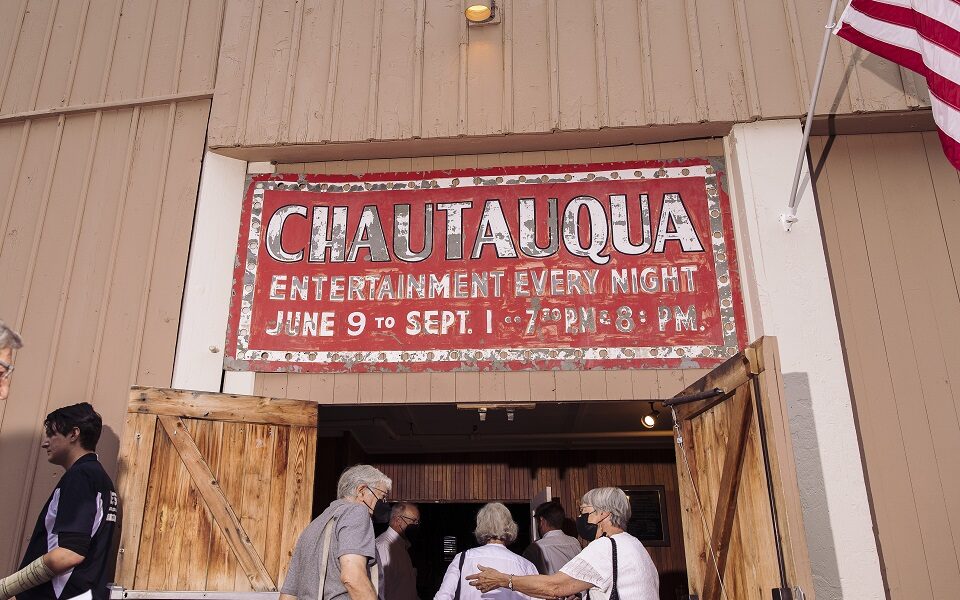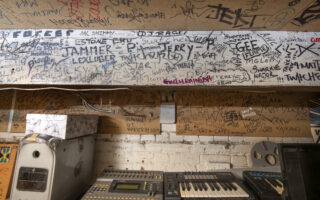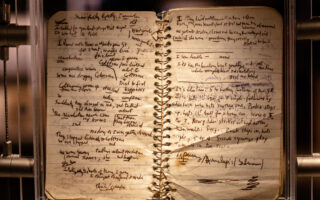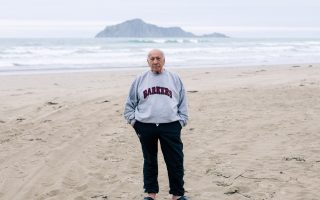A road trip to sample America’s many, many music festivals

Four classical music festivals. Three children. Two exhausted parents, with a brave grandfather in tow. One bedraggled minivan.
It’ll be fun, my wife promised me. Surprisingly, it was.
While some of my colleagues have been taking in the mighty festivals of Europe over the past few weeks – premieres in Aix-en-Provence, France, and the charms of Salzburg, Austria – the revival of programming after the darker days of the pandemic affords the adventurous a fresh chance to get better acquainted with the summer offerings here in the United States.
There are plenty of them, after all. Several of our major orchestras benefit from their own vacation homes, whether Tanglewood for the Boston Symphony or Blossom for the Cleveland Orchestra, Ravinia outside Chicago or the Hollywood Bowl in Los Angeles. Others, not so fortunate in padding their bottom lines with picnickers, play on in their usual halls, or piece together short residencies in various climes.
Then there’s Ojai, and Ravinia, and Spoleto, and Caramoor, and Bard, and Cabrillo and many, many more; if your budget stretches and your stomach is strong, you can even take a jet boat down the Colorado to hear “Quartet for the End of Time” in a riverside grotto outside Moab.
The opportunities are endless, but for anyone interested in combining soundscapes with scenery, as our Junior Rangers demand, one road trip through the mountains begs to be explored.
My family and I – including children ages 6, 3 and not quite 1 – started with the up-and-coming Colorado Music Festival in Boulder, which is within easy reach of Rocky Mountain National Park. Then it made sense to a climb up to the ski resorts west of Denver – first to Bravo! Vail, then to the next valley for the Aspen Music Festival and School. Jackson, Wyoming, didn’t look all that far away, really. There, the Grand Teton Music Festival plays just outside the park of the same name, with Yellowstone National Park an hour to the north. Why not?
We could have left at that, and that would probably have been wise. Still, there’s also an alluring route back south, down through the Canyonlands of Utah and on toward Santa Fe Opera. Tempting.
With the rest of the family flying home, I reported on “Tristan und Isolde” and “M. Butterfly” there recently. But what about the other four festivals, which we visited over 12 days in July?
They are all quite different, serving discrete audiences in distinct atmospheres even if spending time at some of them is expensive, whatever the ticket price. Each has its own idea of what – and whom – a summer festival should be for, and each turned out to be valuable in its own way.
Colorado Music Festival
Glance at it from a distance, and you might mistake the auditorium of the Colorado Chautauqua, where this 44-year-old, five-and-a-bit-week festival is based, for Wagner’s temple in Bayreuth. Built in 1898, it is perched on Boulder’s southwestern flank, the Flatiron rock formations brooding behind it with hiking trails all around. Get there at the right time, and you can just about hear a rehearsal from the playground down the hill. Our youngest watched deer wandering the grounds from his swing, while I eavesdropped on some John Adams.
Fetchingly ramshackle, the wooden hall offers an acoustic that is as comfortable for string quartets as for the festival’s orchestra, and it draws an audience that listens closely. It’s a solid platform, one from which the music director, Peter Oundjian, who has recently taken over the Colorado Symphony in Denver, hopes to turn this festival from a primarily local event to something with broader reach.
That’s an easy enough mission to believe in if you have friends like Adams. Contemporary scores are dotted through even the more traditional evenings here, which this season included commissions from Wang Jie and Wynton Marsalis, and there’s a flair to the programming that mixes slightly unusual works with cornerstones of the canon.
Even so, my visit coincided with the start of a new music week that Adams took part in organizing as composer in residence, albeit without offering any novelties himself. The Attacca Quartet came in for a night to feast on works by Philip Glass and Gabriella Smith, but of the three concerts I heard, the two orchestral programs were most revealing of this festival’s virtues.
Take the second: a brief premiere from Timo Andres, “Dark Patterns,” prefaced Samuel Adams’ Chamber Concerto, a violin concerto in disguise that smartly refracts Baroque forms and was played amazingly by the soloist Helen Kim, before Samuel’s father, John, stepped up to conduct his own, pulsating “City Noir.”
Adams visibly enjoyed himself on the podium, and with good reason: The festival ensemble is an admirable one. The players mostly hail from regional orchestras – the wind soloists, for instance, include regular-season principals from Arizona, Connecticut, Florida and Hawaii – and they come together each summer to play with terrific commitment and no shortage of virtuosity.
They can play pretty much anything, too. The first program I heard was one of three that intriguingly paired the piano concertos of Beethoven with works by Ralph Vaughan Williams. Oundjian busily drew crisp, energetic support for Jan Lisiecki, who was a rather clangorous soloist in the “Emperor” Concerto, but the real shock was the rarefied eloquence that his orchestra lavished on the Vaughan Williams’ World War II-era Fifth Symphony. I’m still thinking about it, weeks later.
Bravo! Vail
Celebrating its 35th season, the delightfully friendly Bravo! Vail is an entirely different kind of affair. Digging deep into its donors’ pockets, it brings three major orchestras, as well as a chamber ensemble, to town for six intense weeks of performances, the most prominent of them in a stunning outdoor amphitheater named for the local vacationer-turned-civic-booster Gerald Ford.
It’s a jaunt that the ensembles clearly value. The fourth one rotates from year to year; this season, it was the St. Paul Chamber Orchestra. But the Dallas Symphony Orchestra just signed up to appear through 2024, while the Philadelphia Orchestra is contracted through 2026 and New York Philharmonic through 2027.
The magical setting – cradled in forested mountains, the amphitheater abuts a botanical garden and backs onto a creek – doubtless has a lot to do with that, and the players and their families have time to enjoy the ski resort’s abundant amenities.
But Juliette Kang, the first associate concertmaster of the Philadelphians, told me during a break in rehearsals that she and her colleagues also take inspiration from the hardy folk who turn down a seat in the pavilion, where the atmosphere is relaxed enough that nobody minded my 6-year-old drawing the flowers behind the stage during Brahms’ Fourth, for the tiered lawn. Out there, where our baby babbled his way through Bruch to no complaints, lightning warnings are routinely ignored and no amount of rain sends the attentive patrons scuttling for cover; tarpaulins, not just golf umbrellas, are necessary here.
Classics and pops are mostly what these audiences brave thunderstorms for – the Texans brought the Beatles as well as Beethoven – even if the artistic director, Anne-Marie McDermott, has valiantly begun a commissioning project that this summer saw three premieres reach the main stage. And the chamber music and free community concert series roam more enthusiastically across the repertoire.
While the Philharmonic often uses its time in Vail to test out programs for the Lincoln Center season to come, the Philadelphians repeated pieces from the season prior, given the single rehearsal on offer for each evening. Nathalie Stutzmann, their principal guest conductor, who was on the podium for the two concerts I heard, said she found that performances seemed to breathe more naturally in the mountain air; there was not even a whiff of complacency in hers.
Vail’s amphitheater, with its four-paned roof redolent of ski runs, offers fair sound, and though it is a tad reticent with details, it has enough body that the Philadelphians still sounded like the Philadelphians. Deluge be damned, Stutzmann turned in one of the most honestly moving Tchaikovsky Sixths that I have heard.
Aspen Music Festival And School
For the musical tourist, the problem with Aspen is that its title is a misnomer.
Founded in 1949 as part of Chicago businessman Walter Paepcke’s plan to turn the town into a haven for the soul and mind alike, this venerable endeavor is best thought of as a finishing school for budding elite musicians.
Although plenty of guest artists pass through for recitals, most of the hundreds of performances have a primarily pedagogical purpose, as the students put to use what they have learned from the enviable faculty. Renée Fleming, no less, now directs the opera program with conductor Patrick Summers.
The festival serves the students, in other words, and the reverse is less the case.
Not that Aspen sprawls quite as much as it once did, despite a $75 million campus renovation that was completed in 2016. Wind the clock back a couple of decades, and you would have found 1,000 students here; this year, officials had to cut an entire orchestra from the program because of a housing shortage, leaving the student body at 500 or so. Alan Fletcher, Aspen’s CEO, said that it was not yet clear whether that number would become the norm.
The Benedict Music Tent, which succeeded two previous structures as Aspen’s main venue when it opened in 2000, could do with as much of a refresh as the programming, which is staid given the usually eclectic tastes of the music director, Robert Spano; next to the glamour of the city, the tent looks unkempt. Tickets also don’t come cheap, though anyone can listen for free on the meadows outside.
That would just about have been worth doing for the concert I heard, a Sunday afternoon feature from the school’s leading ensemble, the Aspen Festival Orchestra, that Fletcher said from the stage was “purely emblematic” of what the school aimed to achieve.
Faculty take the principal seats while their students play alongside them; alumni often return as soloists, in this case the ever-popular violinist Gil Shaham, who shared the spotlight with the excellent young cellist Sterling Elliott in an engaging Brahms Double Concerto.
Although the tent’s acoustic is distant, and the conducting of guest maestro John Storgards in Saariaho’s “Ciel d’Hiver” and Sibelius’ Symphony No.6 was oddly brusque, the playing standards were high. My sense was, though, that they were high not to impress the audience, but someone else.
Grand Teton Music Festival
I’m not sure that the residents of Jackson, whether they are fortunate enough to enjoy their first or their fourth homes in sight of the Grand Tetons, quite understand what they have going for them at Walk Festival Hall, a happily unpretentious, 700-seat indoor theater beside the gondolas in Teton Village.
Donald Runnicles, the music director here since 2006, is a no-nonsense man with a no-nonsense festival. Though a piano series started this year and there are weekly chamber music nights to attend – if you, unlike my wife, can tear yourself away from seeing the sun set from the mountaintop – the main attraction is the Festival Orchestra, which operates on a subscription-season schedule, performing programs twice and rehearsing thoroughly.
It shows. This is another ensemble made up of players from across the country: some retreat here from orchestras as prestigious as the Boston and Chicago symphonies, while a number usually play in opera pits, including at the Metropolitan Opera, and a few are even conservatory professors who come here to sharpen their performance skills. Some stay for the whole season, but most can only manage two or three weeks. If that constantly changing roster might pose problems – five concertmasters are listed in the program book, and 15 horns – it also lends an eagerness to the playing.
Runnicles, one of the most underrated musicians of his generation, knows how to use it. The all-Russian program I heard was of unerring quality, one in which even a political statement was carefully conceived for its musical value.
Before a strong, big-boned account of Shostakovich’s Symphony No.10, which is often thought of as the composer’s declaration of liberation after the death of Josef Stalin, Pittsburgh Symphony violinist Marta Krechkovsky, whose family remains in Ukraine, played the solo line in Myroslav Skoryk’s “Melody,” which has been in wide use as a hymn to freedom since the Russian invasion. Heard in that context, the Shostakovich became all the more immediate.
You could have asked for a mite more focus to the orchestral sound in the concert, though you would struggle to hear a more astounding rendition of Prokofiev’s Violin Concerto No. 2, or anything else to be honest, than the one that soloist Augustin Hadelich contributed.
You could ask for a little more variety in Grand Teton’s programming generally, too, although there’s a dexterity to how it incorporates new music – John Adams’ “Absolute Jest” alongside Stravinsky’s “Petrushka,” for instance – and it’s no small feat to put on Mahler’s “Resurrection” Symphony and Puccini’s “La Bohème” in a place where bears roam the night.
But to quibble like that would be to miss the point; not every festival needs to be an Ojai. What Grand Teton offers, like Bravo! Vail and the Colorado Music Festival in their own ways, is a simpler kind of joy, of good music in glorious surroundings. I know where I’d while away my summer, if I could.
This article originally appeared in The New York Times.






